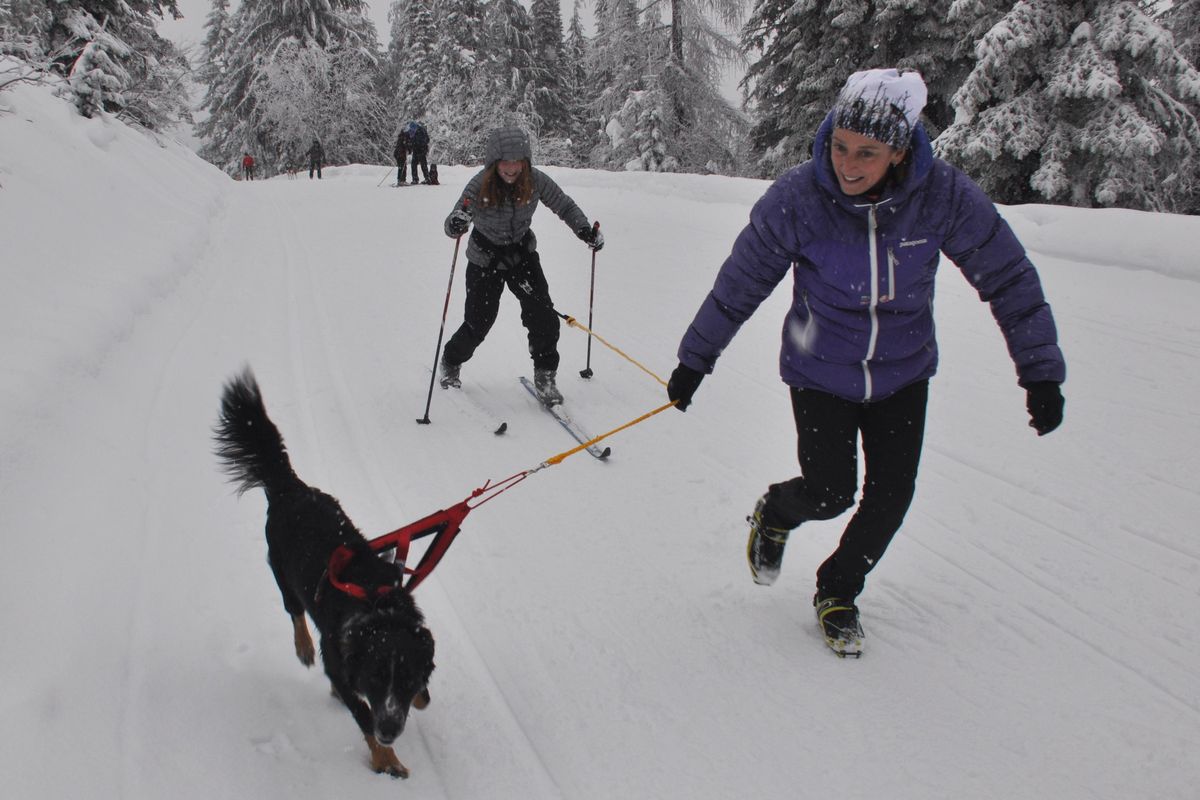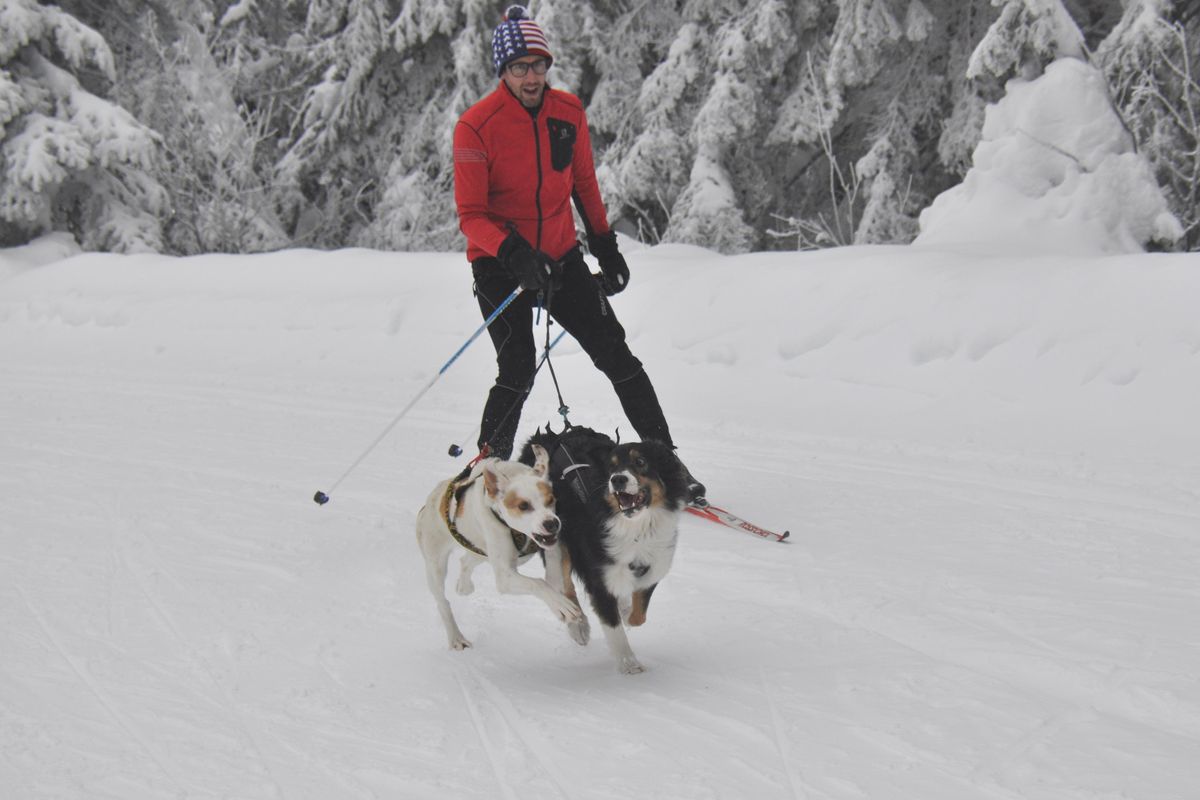Skijoring Nordic skiers let dogs pull their weight through winter
Competitive skijorer Dan Hanks of Coeur d'Alene speeds down Linder Ridge Trail behind his eager-to-pull dogs at Mount Spokane State Park. (Rich Landers / The Spokesman-Review)
They ran the spectrum from timid to exuberant – the canines and humans alike.
But all were game to try a sport that combines Nordic skiing and dog sledding during a skijoring clinic at Mount Spokane on Sunday.
Within a few hours, skills were learned and participants were fulfilling goals of getting a workout and bringing home well-exercised pets during the dog-days of winter.
Instructors ranged from the competitor – Dan Hanks, who qualified last year to represent Team USA in the World Skijor Championships – to the facilitator – Diana Roberts, who won approval 15 years ago from state parks officials and Nordic trails grooming committees to allow tethered dogs on a portion of the Mount Spokane Cross-Country Ski Park.
“Essentials for skijoring include a fitted harness because you never let a dog pull from a collar,” Roberts said.
“But at the top of the list are poop bags,” she emphasized more than once. “We’ve earned the privilege to be on groomed ski trails and there’s nothing that will get us booted off faster than leaving our dog poop. It’s very offensive to other skiers.”
Other essentials include a 10- to 12-foot tug line that includes a built in shock cord to spare the skier and the dog from sudden yanks should the skier fall or, say, a squirrel runs across the trail at an inopportune moment.
Skijorers wear harnesses that ride low on their hips. “The dog can topple you forward if it’s tethered above your waist,” Roberts said. Quick-release attachments facilitate untangling the tug rope in the case of a surprise encounter with, say, a dog in heat or a moose.
Hanks, a private-practice school counselor in Coeur d’Alene, said he got into skijoring to avoid going insane with his high-octane Australian shepherd and border collie. “Now my border collie would go insane if we didn’t go skijoring,” he said.
Although he’s a seasoned outdoorsman and triathlete, Hanks was an unlikely prospect for world competition last year at the age of 38, except for discovering a sport in which he could team with his dogs.
Team Hanks, as he refers to the partnership, plunged into skijoring, training at Mount Spokane – or on Fernan Saddle snowmobiles at the crack of dawn to avoid conflicts – and hurtled into competitive form. He’s won or placed no lower than third in all of his US competitions and ranked as high as 10th in the world competition.
Three points of competitive skijoring enlightenment struck him last winter at the International Federation of Sleddog Sports Championships in Haliburton, Ontario.
- Europeans take the sport very seriously. “They have a obsessive sports mindset to be dedicated and finely detailed. The Fins, for example, had waxing benches they set up right next to the starting line so they could fine tune the wax on their skis up to the last minute.”
- Europeans skijorers are extremely proficient skiers. “Even poor snow conditions don’t hinder them.”
- Europeans have impressive dogs. “They’ve been breeding dogs for skijoring for a long time.”
Hanks still runs two-dog events with Louie, the Australian shepherd, and Lucky, the border collie. But for one-dog events, he acquired Mountain Man, a 70-pound “greyster.” The greyhound-Alaska husky mix has the pedigree for speed and endurance in winter conditions.
“He’s the perfect skijoring dog,” Hanks said. “A couch potato at home that runs like the wind on a ski trail.”
Women are especially proficient in skijoring. “The top women who compete head to head with men are usually around 100 pounds with fast 70-pound German shorthair pointers. And they’re very good skiers and dog people. That’s a winning combination.”
Most people at the Mount Spokane skijoring clinic were out for recreation not competition, including Courtney Kelly with his Doberman named Maker, and Anthony Schoen with his Labradoodle, Scout.
“You two with dogs that already want to pull like crazy, you go with Dan (Hanks),” Roberts said as she moved the group from the lodge lecture to the trails.
Skiers with dogs that might be initially reluctant to pull went with Kate Burns, another veteran skijoring instructor. One team at a time, she made sure dog and skier were properly harnessed. She held onto the dog until the tug line was stretched out and the skier ready.
Then, with a cheery voice, she ran ahead and encouraged the dog to chase after her down the trail.
It worked in every case, although some dogs were a little more prone than others to side-venturing distractions.
All dogs, even the competitive ones, should be started in measured doses of skijoring so they gradually work themselves into condition to maintain enthusiasm and avoid injury, Hanks said.
For off-season conditioning, he throws retrieving dummies on slopes so the dogs have to run uphill.
During winter training, he backs off his skate skiing and lets the dogs do more pulling on hills.
“In competition, though, I ski as hard as I can to conserve the energy of the dogs.”
Roberts offered training tips for teaching dogs to look to the side of the trail when approaching people or dogs to avoid conflicts.
“You have to anticipate what your dog will do,” she said.
“Grab the tug line with your hand and shorten it up until you get around potential problems.”
Skijoring dogs can be trained to ignore wild critters that might show up on the trail, she said, and they can be taught “Haw” and “Gee” commands for going left and right, among other things.
“And you might think about skijoring as going out on an adventure with a 4-year-old child,” she said.
“Some days it will be a wonderful experience, and some days it will require a lot of patience.”





